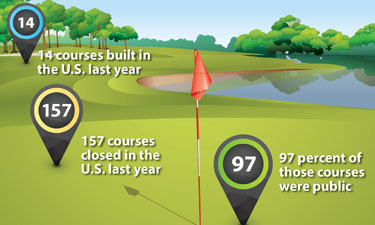 In golf, small numbers are usually better than large ones. However, the smaller numbers seen across the golf industry during the past 10 years are alarming for those who play or manage golf facilities. Since the peak of golf’s popularity in 2005, nearly every measure of golf participation in the United States has demonstrated a decline in both the number of people playing and in places to play, as shown by the statistics from the World Golf Foundation and the National Golf Foundation seen on this page. Using data from PRORAGISTM, we see that the number of agencies offering golf programming and managing golf facilities has also fallen considerably between 2010 and 2013.
In golf, small numbers are usually better than large ones. However, the smaller numbers seen across the golf industry during the past 10 years are alarming for those who play or manage golf facilities. Since the peak of golf’s popularity in 2005, nearly every measure of golf participation in the United States has demonstrated a decline in both the number of people playing and in places to play, as shown by the statistics from the World Golf Foundation and the National Golf Foundation seen on this page. Using data from PRORAGISTM, we see that the number of agencies offering golf programming and managing golf facilities has also fallen considerably between 2010 and 2013.
While the recent past is a grim picture, the precipitous drop in participation has led many in the golf community to take an honest look at how their game is perceived by nonparticipants, and led to innovative strategies designed to make the game more approachable and enjoyable for those new to the sport. It’s also led the golf industry to think of ways to make golf less time-consuming and convenient for those who already love to play, but struggle to find four-plus hours to get out for a round. Many courses across the country are providing 15-inch-wide holes — four times larger than conventional holes — in an attempt to make the game more fun by decreasing frustration, lowering scores and improving pace of play. More than 140 courses in the U.S. are now offering footgolf, a hybrid between soccer and golf where players kick a soccer ball from tee box to green, then putt into a large hole using standard golf equipment. While traditional golf courses are closing by the hundreds, the number of footgolf facilities in the U.S. grew from 35 to more than 140 in about a year. In both of these cases, the time to play 18 “holes” is dramatically reduced compared to a traditional round. These concepts and other variations on traditional golf might be just what many agencies facing hard choices about their golf operations are looking for — and may provide an opportunity for growth where there has recently been dramatic decline.
Learn more about Park Metrics.
Travis Smith, Ph.D., is NRPA’s Vice President of Research.

